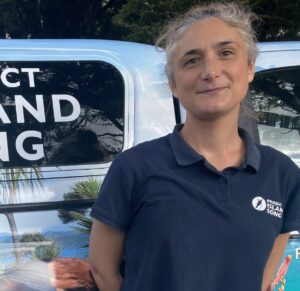
Education and Volunteer Coordinator
Our Floating Classrooms are a unique and engaging opportunity for schools to connect with the conservation work underway on the islands of Ipipiri. This year, nine schools took part during May – July 2024.
The programme begins in class with students engaging with resources about the islands, followed by a class visit from our team to test their existing knowledge and get them ready for their Floating Classroom day on Moturua.
We step straight into real-life learning at Paihia wharf as the students in charge of biosecurity make sure their classmates have scrubbed, checked, and sprayed their shoes, and have no pests hitchhiking in their school bags. If handler Laura and Stella the plague skink detection dog aren’t busy patrolling our ngahere (forests), they’ll meet these groups on the wharf to do a biosecurity check of their bags.
Once they arrive on Moturua island, students connect their classroom learning on pest eradication, planting and species reintroduction with a real world example of how a sustained community effort has enabled this wildlife sanctuary to provide homes and food for some of our most precious endemic life.
As we enter the ngahere on Moturua the toutouwai (North Island robin) often greet us to make the most of the bugs rustled up by our feet. Looking and listening carefully, we see the tīeke (North Island saddleback) foraging in the bark and sharing with the opportunistic pīwakawaka (fantail) following close behind. Students, with sharp eyes, follow a flash of green from the kākāriki (red-crowned parakeet) flying above.
Further highlights this year were a spectacular array of fungi, and a pair of ruru (moreporks) greeting us at the end of the track. An enjoyable part of the day is the construction segment where students work together to build flat-pack rat traps, developing their problem-solving and teamwork skills as we provide no instructions apart from examples of the completed traps and a few helpful hints.
After the Island Day, the Floating Classrooms experience concludes with follow up visits at the schools as an opportunity for students to share their learnings with us, in a wide variety of forms. One student concocted an impressive kanuka and kawakawa blend to be used as either tea or a bath soak (pictured below), while at other schools we had the chance to appreciate some great artwork inspired by the islands, and the chance to see their rat traps in action on the school grounds – there were even some mice caught in the traps on the day we visited!
Our Floating Classrooms are made possible by the generous funding from the Joyce Fisher Charitable Trust, which ensures there is no cost to the schools or students.
Alongside this funding many local groups kindly supported this year’s Floating Classrooms. The team at Kerikeri Mens Shed prepared the rat traps in kitset form for the students. Murry and the team at Bay of Islands ITM generously donated the wood and mesh materials for the rat traps. Rodney and the team at Steel & Tube donated screws for the rat traps.
Island Getaway provided a discounted charter rate for the day to enable the students to get to the islands, and we couldn’t do it without their amazing crew onboard this year’s Floating Classrooms – Adam, Hamish, Tish, Bluebell and Nick.
Finally, many thanks also to the teachers, parents and students that took part this year!